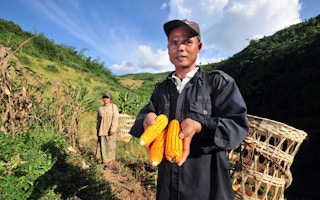We live in a world of fungus. This includes ones like yeasts, mushrooms and antibiotic producers that we benefit from and many others like athlete’s foot and moulds in plants and foods that we don’t benefit from.
To continue reading, subscribe to Eco‑Business.
There's something for everyone. We offer a range of subscription plans.
- Access our stories and receive our Insights Weekly newsletter with the free EB Member plan.
- Unlock unlimited access to our content and archive with EB Circle.
- Publish your content with EB Premium.
Climate change, and the warmer and more humid conditions it brings, is predicted to accelerate the growth and diversity of fungi in the environment. This will mean much greater threats to health particularly from foods susceptible to carrying mycotoxins, which are toxic substances produced by fungal moulds.
Over the last five decades, it’s been shown that cereals, nuts, spices, dried fruits, coffee, cocoa, fruit juices, grapes and red wine may all contain mycotoxins under warm and humid conditions—the kinds of conditions that are typical of Southeast Asia especially.
Because of the severity of the health risks involved, we need to start thinking much more about fungi and the impact of climate change. Many of the mycotoxins that enter human and animal food chains are ‘hidden’ and aren’t killed off by heat or other kinds of food processing. For instance aflatoxins, especially aflatoxin B1, can damage DNA and cause liver cancer in humans and animals.
Other mycotoxins have a range of health effects including kidney damage, gastrointestinal impacts, reproductive disorders or suppression of the immune system. The most recent serious outbreak reported is of schoolchildren in rural Kenya who had consumed mouldy maize, resulting in about 150 fatalities and up to 500 children being hospitalised because of acute exposure to aflatoxins.
A report from the World Health Organization in February 2016, Mycotoxin Control in Middle and Low-Income Countries, warned that the issue of mycotoxins in the food chain had been ignored for too long and needed a coordinated international response. Aflatoxins have been regularly identified as affecting crops of maize and peanuts in India and Thailand, as well among coconuts in the Philippines, Sri Lanka and other countries in Asia Pacific.
What’s climate change got to do with it?
Pests and fungal diseases are on the march (at an estimated rate of 6km per year from the equator outwards to the poles) and that’s a result of some of the key characteristics associated with climate change: higher temperatures at times of year when crops are being harvested, stored and transported; higher levels of rainfall and more humidity, a damper atmosphere, which encourages all types of fungal growth; and crop stress caused by drought conditions.
In the new milder climate conditions there are therefore risks of mycotoxin contamination increasing in regions which have been relied upon as the ‘bread baskets’ for food production. Increased contamination levels may occur of existing mycotoxins, or emigration of other mycotoxins may occur to new regions where they were not previously prevalent.
A key issue in the Asia-Pacific region is the impact of mycotoxins on cereal grains. Harvesting periods tend to coincide with the start of the rainy season, when drying crops in the sun is less likely. Damp grains combined with humid conditions are perfect for mycotoxin growth. For this reason, the aflatoxins level in Asian cereal grains exceeds the permitted limits for export to Europe. Cases of aflatoxin poisoning and liver cancer among humans are concentrated in Asian countries—such as India, Indonesia, the Philippines, Taiwan and Thailand—where more people rely on maize in their diet.
Our recent studies at Cranfield University have looked at the role of one of the most fundamental factors behind climate change, the impact of increased levels of CO2. They have shown how higher CO2 levels combine with higher temperatures to further increase the likelihood of growth of mycotoxins—more of the dangerous aflatoxin B1 will be produced on maize-based substrates or maize grain in future. This will have profound implications in terms of mycotoxin contamination of cereals.
“
Cereals, nuts, spices, dried fruits, coffee, cocoa, fruit juices, grapes and red wine may all contain mycotoxins under warm and humid conditions—the kinds of conditions that are typical of Southeast Asia especially.
Another core issue is the impact of climate change on our extended global supply chains, storage and transport in different climates. Hygiene is critical during medium and long-term storage and during transport of food and feed commodities, and will be affected by higher levels of warmth and humidity. Many food products are ‘hygroscopic’, meaning they can easily absorb water and allow mycotoxigenic moulds to grow, and perhaps increase contamination.
Often, only a small change in the conditions for dry goods can result in contamination with mycotoxins above the legislative limits. In 2014, 35 per cent of rejections of human food or feed for animals at EU borders were due to mycotoxin contamination levels above what’s allowable for health.
Mitigating the rise of mycotoxins
Minimisation strategies have included the use of relatively resistant varieties (where these are available), good pre-harvest agricultural practices, proper timing of application of chemical or biological control treatments for pests/fungal infection, and taking into account the weather conditions during transport.
But the problem of mycotoxins varies with season and is very unpredictable in temperate regions of the world. As a result, more integrated approaches are being introduced to combine different types of environmental and crop data, pre-harvest and post-harvest, to try and provide an early warning of the relative risk of specific mycotoxins and minimise contamination.
We’ve been working on a project since 2016 by producing a set of tools to help farmers identify and deal with mycotoxins. Two Master of Science programmes at Cranfield have been set up to prepare food professionals for dealing with the challenges of a new world of food, the threats from climate change, including mycotoxins, and managing the effects across whole food chains.
But the issue continues to be a lack of awareness of the threat—unlike most pests and viruses, we don’t even know what new or even existing fungi are out there in the environment; they’re ever-changing.
In Asia, there have been particular challenges in tackling the mycotoxin issue, including a lack of awareness among farmers and the organisations that have the resources to fight it. Regulatory policies on dealing with contaminated produce are also scant.
What’s needed now is more monitoring and shared international data about the spread of mycotoxins, and putting in place the early warning systems needed to provide the necessary awareness and control of these dangerous fungi.
Dr Angel Medina-Vaya is a Lecturer of Food Mycology at the Cranfield Soil & Agrifood Insitute, Cranfield University. This article was first published on Eco-Business.


















